Grains
- Animals, Bees, Gardening adventures, Grains, Health, Heirloom Plants, Herbs, Other Insects, Permaculture and Edible Forest Gardening Adventures, Planting, Seeds
Growing and Eating Seeds
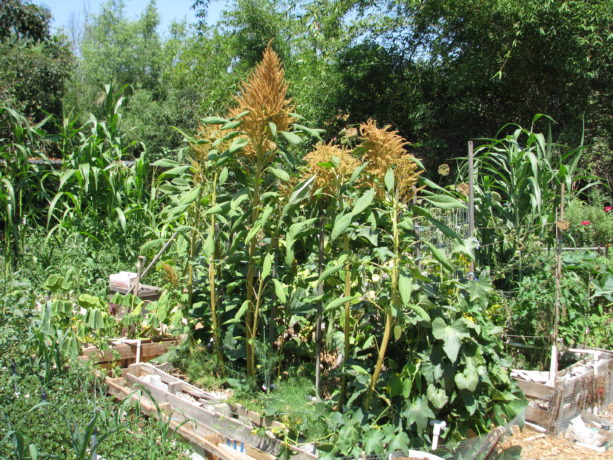 We eat seeds everyday. Grains, nuts, beans and, well, seeds, are all seeds. A seed is an embryonic plant covered with a seed coat. A grain is a dried fruit. In this blogpost I’m going to concentrate on true seeds.
We eat seeds everyday. Grains, nuts, beans and, well, seeds, are all seeds. A seed is an embryonic plant covered with a seed coat. A grain is a dried fruit. In this blogpost I’m going to concentrate on true seeds.Grains are usually seeds from grasses, although there are common exceptions to that rule such as the amaranth below. Seeds contain the magic that makes a plant out of a speck; a towering oak from an acorn. Seeds are highly nutritious for humans as well, but often are just used as a flavoring (think of an ‘everything’ bagel). Many have been used medically for relieving everything from eczema to mental issues. Some seeds such as grains are difficult to prepare for eating on a small scale, such as rice. Separating seeds from chaff takes a lot of steps that may not be practical for the handful of food at the end of the process. However there are many seeds that we commonly eat that are easily grown among the veggies, or even in a flower bed. Here are some that we grow at Finch Frolic Garden Permaculture:
Let’s start with one of my favorite flavors, the sesame seed.
 Sesame (Sesamum indicum) seeds grow on small upright plants about 2 – 3′ high that have lovely tubular flowers.
Sesame (Sesamum indicum) seeds grow on small upright plants about 2 – 3′ high that have lovely tubular flowers. 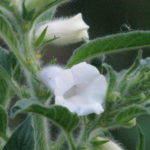 Bees love to crawl into them. Its a pretty plant and flower, so could easily be incorporated into an ornamental area. There are both black and white sesame seed plants; the white seed is really brownish as it has a seed coat. Sesame is also called benne seed. Once harvested sesame seeds should be stored in a dark cool place or refrigerated. The seeds can be used raw, or better still lightly toasted in a dry pan before sprinkling over your food. So very yum. Tip: sesame pods become tight as they dry and then split with force, throwing the seeds away from the plant. If you want to harvest any then watch the pods as they dry on the plant and then cut and hang in a paper bag to catch the seeds as they fly, or break open with your hands.
Bees love to crawl into them. Its a pretty plant and flower, so could easily be incorporated into an ornamental area. There are both black and white sesame seed plants; the white seed is really brownish as it has a seed coat. Sesame is also called benne seed. Once harvested sesame seeds should be stored in a dark cool place or refrigerated. The seeds can be used raw, or better still lightly toasted in a dry pan before sprinkling over your food. So very yum. Tip: sesame pods become tight as they dry and then split with force, throwing the seeds away from the plant. If you want to harvest any then watch the pods as they dry on the plant and then cut and hang in a paper bag to catch the seeds as they fly, or break open with your hands.Amaranth:
Amaranth (Amaranthus spp.) is a very tasty, easily grown seed that is considered a grain. It was a major food of the Aztecs, and almost completely destroyed by the Spanish after their conquest of that civilization. Amaranth was too sneaky though and survived. It is easily digestible, high in protein and full of other nutrition. It has wild as well as ornamental varieties, but all are edible (be sure what you are eating!) Love-lies-bleeding is the dramatic name of the long red tasseled kind.
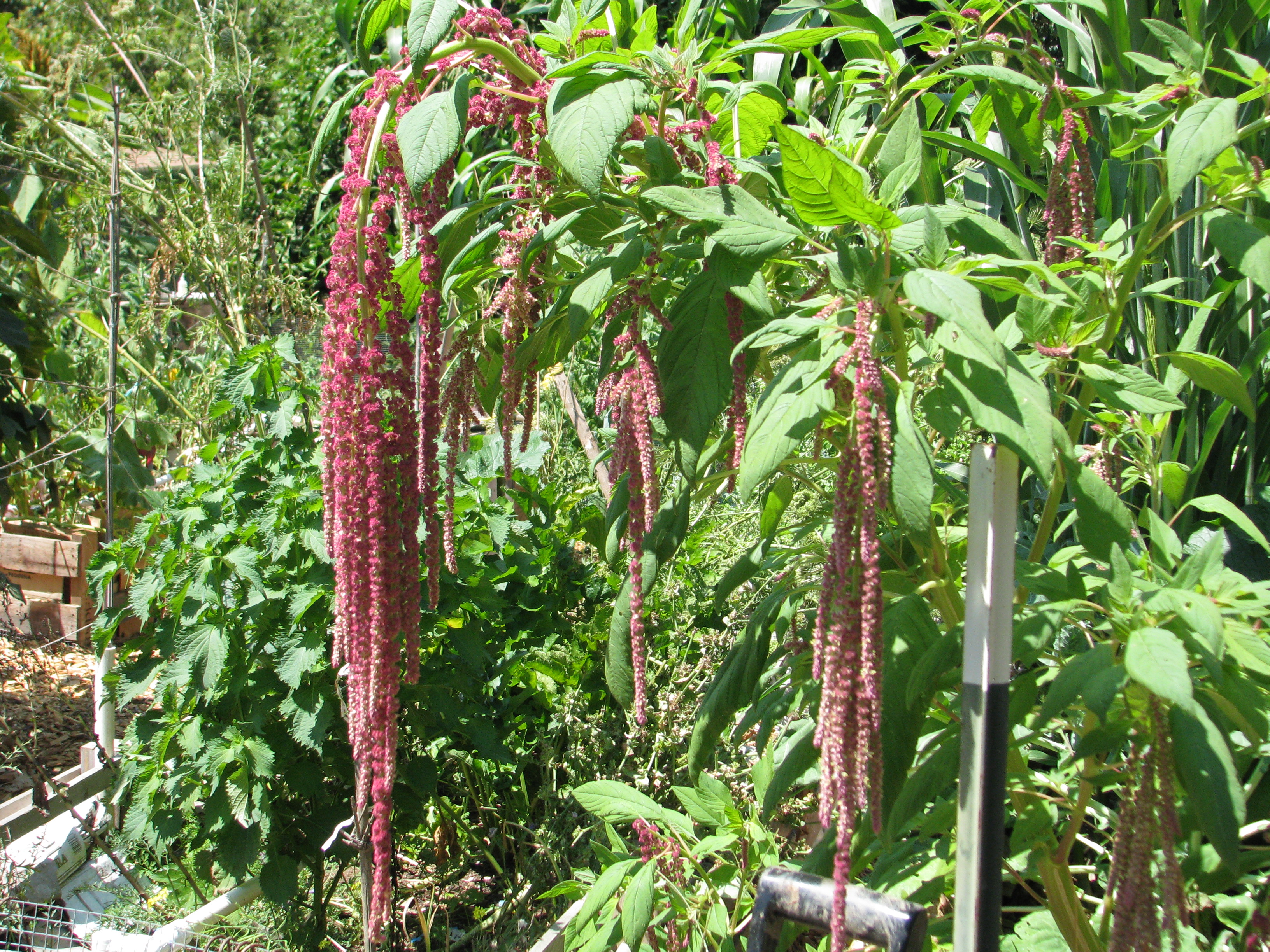

All are great for birds as well as humans.
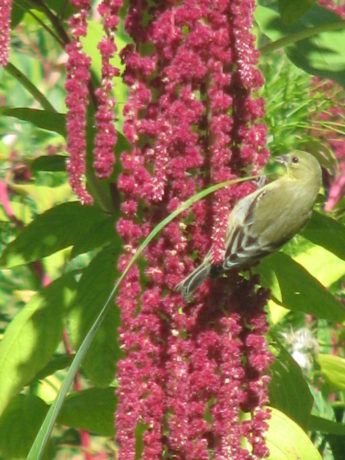
Pigweed and lambsquarter are its weedy relatives. All of them have edible leaves, although some varieties are more tasty than others. Older leaves are better cooked. The tall varieties can grow 8′ tall or so, may need staking, and make good shade plants for others that need sun protection. When you start to see birds on the flowers then the seed should be ready. Another way to check is to gently rub the flowers between your fingers and see if seeds come off as well as the petals. If so, then over a clean, dry bucket rub the cut flowers between your fingers. Winnow the chaff away over a mesh screen or in the wind, or by gently blowing it away from the seed. Now you need to completely dry the seed in the sun, and then store in a dry, dark cool place. Use within six months for best results.
Poppy seeds:
 No, not the opium kind, the lemon-poppy seed cake kind, although both are varieties of Papaver somniferum. Look for seeds for Breadseed Poppy varieties. This is another beautiful ornamental with striking seed pods that can be dried and used in flower arrangements. Poppies enjoy poor, disturbed soil. The seeds are tiny so need to be exposed to daylight to germinate. The flowers are beautiful; frail and feminine. The seed pods are rounded and have tiny holes at the top where the seeds come out of, so be careful when you are working around the drying pods or you’ll scatter seeds. Or just let some drop and they will come up next year.
No, not the opium kind, the lemon-poppy seed cake kind, although both are varieties of Papaver somniferum. Look for seeds for Breadseed Poppy varieties. This is another beautiful ornamental with striking seed pods that can be dried and used in flower arrangements. Poppies enjoy poor, disturbed soil. The seeds are tiny so need to be exposed to daylight to germinate. The flowers are beautiful; frail and feminine. The seed pods are rounded and have tiny holes at the top where the seeds come out of, so be careful when you are working around the drying pods or you’ll scatter seeds. Or just let some drop and they will come up next year.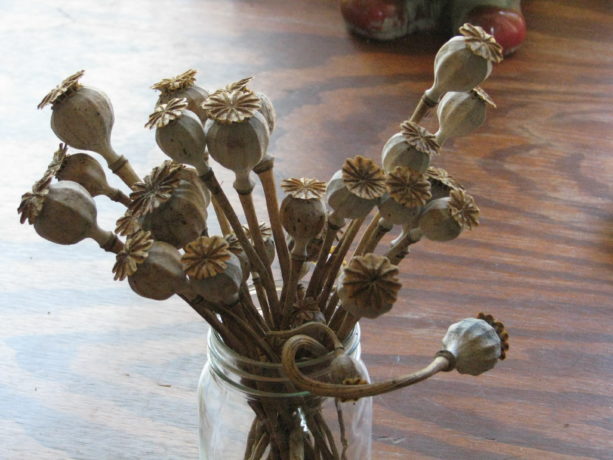
 Allow the pods to dry on the stem and then carefully cut. Shake the seeds out into a jar and store in a cool, dark place. Use raw or lightly toasted. Be sure not to eat them before taking a drug test, or you’ll test positive.
Allow the pods to dry on the stem and then carefully cut. Shake the seeds out into a jar and store in a cool, dark place. Use raw or lightly toasted. Be sure not to eat them before taking a drug test, or you’ll test positive.Basil seeds:
 Basil seeds aren’t well known for their culinary use in the US, but they are nutritious and useful. The seeds of the sweet basil plant (Ocimum basilicum) not Holy Basil (Ocimum tenuiflorum), when soaked make the water gelatinous, as chia seeds do, so are used to thicken drinks and foods. You don’t have to soak basil seeds to use them though. The flowers are delightfully edible as well. Use them for additional flavor and nutrition by tossing them raw into salads, salad dressing, breads, or just about anything. Letting some of the basil plant go to seed (while pinching other stems to keep it leafing) will attract small native pollinators to your garden. When the flowers dry, the seeds are ready to be shaken off into a clean, dry bucket or bag.
Basil seeds aren’t well known for their culinary use in the US, but they are nutritious and useful. The seeds of the sweet basil plant (Ocimum basilicum) not Holy Basil (Ocimum tenuiflorum), when soaked make the water gelatinous, as chia seeds do, so are used to thicken drinks and foods. You don’t have to soak basil seeds to use them though. The flowers are delightfully edible as well. Use them for additional flavor and nutrition by tossing them raw into salads, salad dressing, breads, or just about anything. Letting some of the basil plant go to seed (while pinching other stems to keep it leafing) will attract small native pollinators to your garden. When the flowers dry, the seeds are ready to be shaken off into a clean, dry bucket or bag. Coriander:
You probably know cilantro or Chinese parsley as the love-it-or-hate-it herb found in salsas and many Mexican or East Indian dishes. Cilantro (Coriandrum sativum) seed is called coriander. Coriander seed is usually used ground and used in curry mixtures, soups and meat dishes. It is an historical herb, being used in ancient India, China and Egypt. It has a kind of lemony taste that is unique.
Celery seeds:
Celery (Apium graveolens) seeds are marvelous savory additions to soups, particulary tomato. I grind it up in a mortar and throw it in soups and stews to round out the flavor. We grew celery one year -although I have no photos of it – and because of the warm weather the celery stalk flavor was quite strong. However the seeds were delightful. Celery is a cool-season plant and the stalks should be covered to keep pale green and mild flavored. Or just let them grow for the seed. There is a wild variety that grows in marshlands, but please be very careful if you harvest from it because it looks similar to the very poisonous water hemlock (Cicuta).
Fennel:
If you’ve sipped ouzo, aguardiente or anisette, you’ve tasted the seeds of the fennel plant. Fennel (Foeniculum vulgare) is the brother of anise, and both have escaped gardens to be a troublesome weed. Fennel bulbs are absolutely amazing lightly steamed, and then baked in vegan butter and topped with vegan Parmesan. The leaves are fantastic stirred into eggs or salads, and the seeds are incredible flavorings for baked goods, candies and obviously alcohols. Miranda candied fennel seeds for me. They have been used to try and mask cigarette or alcohol breath, but really… who is kidding who? They do make a great breath freshener chewed. The plants are frondy, tall and have pretty umbels of flowers that native insects love.
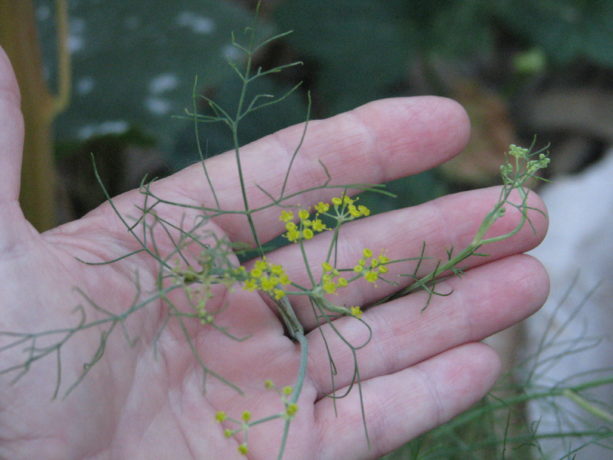 Grow some for the bulbs (protect them from gophers!) and let others go to seed. Cut and hang upside down to collect the seed in a bag or else you’ll have fennel everywhere. And that may not be a bad thing.
Grow some for the bulbs (protect them from gophers!) and let others go to seed. Cut and hang upside down to collect the seed in a bag or else you’ll have fennel everywhere. And that may not be a bad thing.Sunflower
I don’t know anyone who isn’t familiar with sunflower seeds; certainly the shells were routinely spit out all over campus as a cool snack when I was in college and probably still are. At least they are biodegradable. Sunflowers (Helianthus annuus) are one of the few edible seeds native to North America, and they are protected in an attractive hull. Some varieties are small, multi stemmed and ornamental, and others are grown for their fabulously large seed heads. Birds love eating the green leaves as part of their healthy diet, so grow extra. The seed heads should be left to dry on the stalk, and then cut and shaken to de-seed. Good pollination is important to produce seeds with good ‘meat’ inside.
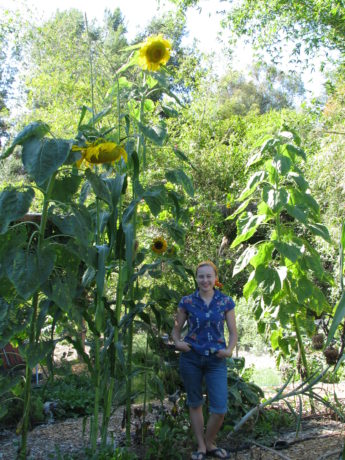
Eat them raw or toasted; they are full of good things for your body. (Miranda is 5’1″ in the photo, not tiny. I like that one of the heads seems to be checking her out.)
Dill
Dill (Anethum graveolens) is another double happiness plant. The leaves are tremendous used fresh or dried, and the seeds are fantastic as well. We use the whole seed heads in our dill pickle recipe. It goes well with fish, or in our case vegan fish. Grind them or use them whole, but definitely stir them into sauces, soups, dressings, dips, etc. Dill, like fennel, will reseed, but that isn’t a bad thing. They look pretty much like the fennel plant above.
Caraway:
We’ve grown caraway (Carum carvi) in the past, but I have no picture for you. Just refer to the photo above of the fennel and it will be close, as they are in the carrot family. You’ll find caraway in rye breads, liquors and cheeses, and in some areas the young leaves and roots are also eaten. They are dried and harvested just like the fennel and dill.
There are other seeds that we haven’t grown. We’ve tried to grow cumin and annatto seeds, but have failed to make them germinate; there is always next year. Some seeds are so small, such as chia, that you’d have to grow a lot of plants to harvest just a little seed. Seeds are such a vital nutritional and flavorful part of our diets, and so fun to grow that everyone should sprinkle edible seed-bearing plant seeds throughout their garden. As seeds dry and keep fresher longer than dried leaves (such as basil or dill), that fresh taste of the garden can last through until next year’s harvest time again.
- Animals, Chickens, Cob, Compost, Composting toilet, Fruit, Gardening adventures, Giving, Grains, Health, Herbs, Houses, Hugelkultur, Humor, Living structures, Natives, Natural cleaners, Permaculture and Edible Forest Gardening Adventures, Ponds, Rain Catching, Recipes, Seeds, Soil, Vegan, Vegetables, Vegetarian, Worms
San Diego Permaculture Convergence, Nov. 9 – 10, 2013
There is a fantastic, information-packed permaculture convergence coming up at the beautiful Sky Mountain Institute in Escondido.
 It will be two days packed with great information for a very reasonable price; in fact, scholarships are available. Check out the website at convergence@sdpermies.com. On that Sunday I’ll be teaching a workshop about why its so important to plant native plants, how to plant them in guilds using fishscale swales and mini-hugelkulturs. Come to the convergence and be inspired!
It will be two days packed with great information for a very reasonable price; in fact, scholarships are available. Check out the website at convergence@sdpermies.com. On that Sunday I’ll be teaching a workshop about why its so important to plant native plants, how to plant them in guilds using fishscale swales and mini-hugelkulturs. Come to the convergence and be inspired! -
Jook
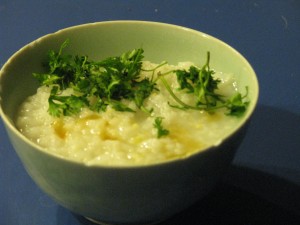
Jook with sesame oil and chopped cilantro Jook, Juk, Chinese rice soup, rice porridge, congee… these are many names for basically the same food, rice cooked with a lot of water. There are equally as many ways to fix this wonderful comfort food. Jook can be made with plain water and white or brown rice, then served with toppings such as cilantro, sesame oil, chopped peanuts, bits of cooked tofu, soy sauce, chopped hardboiled egg, preserved or cooked vegetables, chives… as little or as much as you’d like. Jook can be prepared with or without salt; I prepare mine without, then grind a little on the top when serving for that little burst of flavor. Jook can be served with cinnamon and sugar for dessert; this is especially nice for those who love rice pudding but don’t want to eat or can’t eat dairy. Commonly eaten as a savory breakfast dish, Jook is also a perfect food for when you are ill. Not only is it comforting and filling, but it is easy to eat for a sore throat, easy on a troubled stomach, nutritious, and if you are a victim of Montezuma’s Revenge (if you know what I mean), rice is very good for helping you to stop going. Ah-hem. Jook is a very good baby food for those little mouths that are just getting into semi-solids.
You can find hundreds of different versions of Jook on the Internet. Many make it with part broth, part water. Some throw in fresh ginger, some cook bones in it for added calcium. Cooking it plain allows you to top each bowl up the way you want, which is what I do. Leftover Jook can be mixed with water to loosen it up, or eaten in its more solid form. You can’t get a much easier comfort food to make that is so versatile. It is particularly good for celiacs (those who cannot eat gluten). With cooler weather upon us, make one dinner a Jook day!
JookAuthor: Diane C. KennedyRecipe type: MainPrep time:Cook time:Total time:Serves: 6-8Jook, rice porridge, rice soup or congee, is a wonderful versitile comfort food.Ingredients- 1 cup washed white rice (short or long grained depending on your taste)
- 8 cups water (if you like it thick)
- or
- 10 cups water (if you like it medium)
- or
- 12 cups water (if you like it very thin and soupy)
- optional: 1-2 tsp. salt)
- optional: substitute broth for equal parts of the water)
- optional: add a thumb-sized knob of fresh ginger)
- Topping suggestions:
- sesame oil, peanuts, fresh cilantro, chopped hardboiled egg, cooked tofu, seaweed, soy sauce, freshly ground salt and pepper, butter, cooked vegetables, pickled vegetables... leftovers. Also make it sweet with sugar, honey, cinnamon, nutmeg, dried fruit, chocolate chips!
Instructions- Put washed rice and the desired amount of water in a dutch oven
- Heat until boiling
- Turn down heat to a simmer and cook uncovered 2½ - 3 hours, depending on how thick or thin you want it.
- Serve hot in small soup bowls with choices of toppings.
-
Crazy Pot Salad

- Mixed greens plus blossoms, herbs and tiny potatoes
Crazy Pot Salad is what my daughter calls a main dish I make because it involves many different ingredients that vary as to availability. It always turns out great, though, which is truly amazing. It is a greens salad that also has cooked items and a balance of flavors, textures and colors that make every forkful slightly different. It involves both cold and hot ingredients, all thrown into the same bowl and mixed together to create a melded warm dinner that is as healthful as it is delicious. It is even good as cold leftovers the next day.
Tonight’s salad was born of the need to eat the mixed salad greens that were overgrowing in the garden. I cut and picked various greens and started from there. To create a Crazy Pot Salad, I keep in mind these components:
Fresh Greens: the more varied the better. Fresh herbs such as dill, basil, chives and cilantro, along with arugula and a lettuce mix, work well. Don’t forget some iceberg for crunch. If you don’t have or want to use iceberg (a much maligned vegetable) then cut up fresh celery.

- A mix of colors and textures is essential
Protein: Tofu, soy chicken strips (such as Morningstar Farms), soy bacon, soy tuna, etc. Beans such as garbanzo or Northern white work well. Using a couple types of proteins are tastier and more nutritious. Cook the protein and use hot.
Starch: Pasta in small shapes, rice, or a cooked grain such as quinoa. Use the starch hot.

- Quinoa (pronounced keen-wa) is high in Omega-3.
Other additions: diced carrots, steamed tiny potatoes or potato chunks (hot), feta or cotija cheese (crumbly), marigold petals, nasturtium blossoms, squash blossoms, capers, heart of palm, mushrooms, pea pods, avocados, green beans fresh or cooked… whatever you have that you need to use. Look for colors to add. I can’t stand Bell peppers, but that is usually the go-to choice when people want to add color to anything. You can avoid the Bell pepper taste-takeover of your salad if you want with a little creativity. Stir-fry up some chopped red cabbage and throw it in with some raw carrots.
Crunch: Nuts, such as pignoli (pine), cashews, sunflower seeds or almonds. Toast them in a little olive oil or in the toaster oven to bring out their flavor.
Dressing: This salad just about makes its own dressing. I like to make Italian dressing with a packet of Lowry’s Italian dressing mix, using red wine vinegar and olive oil. Or I make the dressing as I cook, which I’ll include in the recipe. The cooked shiitake mushroom gives the olive oil a deep, savory note and adds a very interesting flavor and texture. Along with the pignoli nuts, chives and crumbled soy bacon, this makes a delicious subtle dressing that is mixed into the salad rather than adorned on the top. The hot starch, including the potatoes, will readily absorb the hot flavored olive oil.

- Shiitake mushrooms, pignoli nuts and soy bacon dressing
Remember, this is a salad of opportunity; use what you have and what you love, but keep in mind the different components, the shapes and colors of the ingredients, the texture and nutritional value. Bland foods such as the potato will balance strongly flavored ones such as arugula.

- Yum. Just: yum!
Crazy Pot SaladAuthor: Diane C. KennedyRecipe type: Main Dish SaladPrep time:Cook time:Total time:Serves: FourThis warm combination of greens and other ingredients make a balanced, delicious healthy main dish that can change with what you have available.Ingredients- One cup quinoa, prepared with vegetable broth following box directions
- Four cups (approx.) mixed fresh greens washed and torn into bite-sized pieces
- Two sprigs each fresh dill, basil, chives and cilantro, chopped
- One cup torn iceberg lettuce
- Three calendula flowers and four squash flowers, torn into small pieces (just petals)
- Eight very small potatoes
- Cotija cheese (or veggie substitute. Dairy can be optional)
- Half an 8-oz can garbanzo beans
- Two small carrots, sliced into discs
- One tomato, diced
- A tablespoon olive oil (flavored, if you have it)
- One package Morningstar Farms Chicken Strips
- For Dressing:
- Six fresh shiitake mushrooms
- Four strips Morningstar Farms soy Bacon Strips
- Three tablespoons pignoli nuts
- ⅛th cup olive oil
Instructions- Prepare quinoa in medium saucepan using vegetable broth, according to the instructions on the box.
- Steam small potatos until tender
- Meanwhile, wash, dry and tear up fresh greens, herbs, iceberg and flowers. Put in large bowl.
- Crumble about four tablespoons Cotija cheese over greens in bowl.
- Add garbanzo beans
- Add carrot discs
- In frying pan, heat a tablespoon of olive oil and stir-fry the soy chicken strips until browned (if you have flavored olive oil, such as citrus or basil, use that to cook these).
- Add hot soy chicken strips to bowl.
- In same frying pan, heat ⅛th cup olive oil on medium high.
- Chop shiitake mushrooms and add to frying pan.
- Cook mushrooms on medium-high heat until they are almost crunchy.
- Add soy bacon strips and pignoli nuts.
- Stir nuts until they are browned (watch so they don't burn).
- Flip bacon and remove when browned.
- Pour contents of pan on mixture in bowl.
- Crumble bacon strips and add to bowl.
- Add steamed potatoes, quartered to bowl.
- Add quinoa to bowl.
- Toss contents of bowl until well mixed. Heavy ingredients will sink to the bottom, so be sure to mix well.
- Plate the salad and garnish with chopped tomatos and more cheese, if using.
- Bees, Gardening adventures, Grains, Permaculture and Edible Forest Gardening Adventures, Ponds, Vegetables
What’s Happening in the Veggie Beds
“When planting seeds plant four in a row: one for the mouse, one for the crow, one to rot and one to grow.” (unknown).
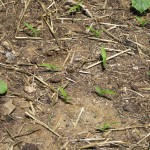
Baby Baby Corn I know what you’re thinking; you’re thinking, “Oh, no! Not more about peas again!” Well, yes, a little more about peas. It was time for them to go. I grew most of them from old seed just to use it up and to set nitrogen in the soil, since they are legumes. Some plants even had powdery mildew on them, which surprised me.
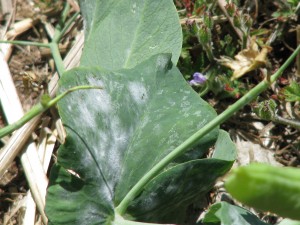
Powdery mildew I had to cut the plants off at the roots instead of doing it the easy way and pulling up the whole plants.
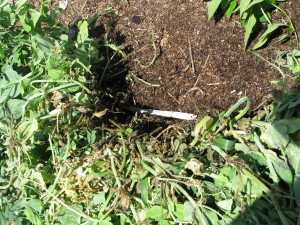
Cutting peas at their roots Since I’d hurt my right wrist a few weeks ago and I still haven’t allowed it to heal enough, the cutting wasn’t a fun job. It was worth it, though. I left the roots with their nitrogen-fixing nodules in the ground where they would do the most good.
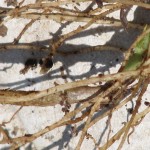
Peas set nitrogen in their roots Then I took all the pea vines up to the driveway, set up a chair, put on shorts and stuck my pale legs in the sun, plugged in an audiobook, and spent about an hour and a half tearing pea pods off of all the vines.
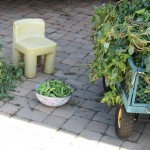
Harvesting time That night after dinner I began sorting through the pods and shelling them. I’m still not done.

Pea harvest I managed about half a big bowl of peas, which I sleepily shoved into the refrigerator before stumbling up to bed. My son was very calm in the morning when he told me about his surprise when he went for a midnight snack and spent about half an hour gathering up peas from the floor and adjacent rooms. I worked on more peas tonight. I’ve already frozen a couple of bags for our use; the rest will be frozen and used to feed the tortoises and chickens. All those pods and vines will combine with trash cans full of weeds I’ve been pulling along with kitchen trash to reconstruct my compost pile.
But there is life beyond peas. There are beans! I’ve planted several types of beans this year. Fresh green beans as well as soup beans and pinto beans. I’ve created two new raised beds and set them off from the rest of the garden. In them I’ve planted sugar baby watermelon, green melon, sugar baby pumpkin, and butternut squash.
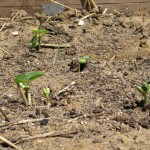
There's a pinto bean on the rise These vines will grow out rather than over other garden beds. In the middle of the beds I’ve planted pickling cucumbers, baby corn and pinto beans. They will all grow tall above the vines writhing and twining below. ( Hmm. Note to self: stay away from vine beds at night.)
Here’s an interesting piece of trivia: most gardeners have heard about ‘the three sisters’, which are the Native American pairing of corn, beans and squash. Actually, it should be four sisters, at least for Southwest Indians. The concept of the ‘sisters’ is that they form a complete plant ‘guild’. In other words, these three planted in combination produce more food than any one planted alone. The corn provides a trellis for the beans, the beans are a legume that fix nitrogen in the soil with nodules on their roots that feed off of sugars secreted by the corn roots (all this going on beneath your feet! Yikes!), and the squash forming a cooling, weed-suppressing ground cover that also deters raccoons (notorious corn-eaters who don’t like to walk through the vines). What is missing is a plant to attract and feed the pollinators. In the Southwest Anasazi settlements it was Rocky Mountain bee plant (Cleome serrulata), which has edible parts to it and fixes iron (the Anasazi used it as a dye plant as well as food). With an edible plant guild, we feed the soil and the pollinators as well as ourselves. You can read more about this in the fantastic book on permaculture by Toby Hemenway, Gaia’s Garden. An excerpt is right here: http://patternliteracy.com/the_three_sisters_or_is_it_fou I’m trying my fourth sister as dill weed, which is an excellent bee plant because of it’s small umbellate flowers. Dill also goes well as a flavoring for corn, cucumber and squash, and usually plants that complement each other taste-wise do well planted together, such as basil and tomatoes.
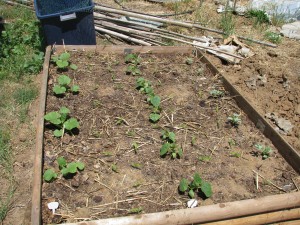
Cucumber, baby corn, watermelon and squash Speaking of which, my garlic/shallot/tomato and basil bed has taken off with the warmer weather. These are slicing tomatoes; I have planted Roma and a yellow variety in other beds.
Where the peas have come out, the broccoli, carrots, parsnips, lettuces, endive and cilantro are doing well. I’ve planted some small eggplant sprouts and more carrot seed so there is a continuous supply.
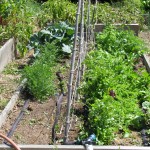
Life without pea plants Organic sweet corn will go into this bed, which will provide shade for the lettuces. Corn of different varieties must not come into silk simultaneously or they will cross-pollinate. The baby corn in the other bed will mature earlier by nature and by planting times. Those little corn ears can be eaten fresh or left to harden to be used for popcorn. The whole ear can be put into a microwave, for those of you who have such a newfangled contraption (I haven’t owned a microwave, um… ever!).
We’ve had new visitors to the garden. Besides my gopher snake friend (see my post Unsticking the Snake of May 14th), who has been seen again, and a longer gopher snake, my son and I saw a king snake whipping down a gopher hole in the lower Bee Garden, and then today this fellow came through the Chicken Tractor then through the Swiss chard and onion bed, and across the property.
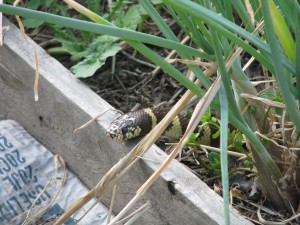
"So good to rest my weary head for a minute!" I’ve only seen one king snake in the yard who shows up in the height of summer to look for mice under the bird feeders. The standing water in the pond and the disturbance of the soil has attracted more of these friends, especially since my dogs are elderly and aren’t ‘making the rounds’ like they used to.
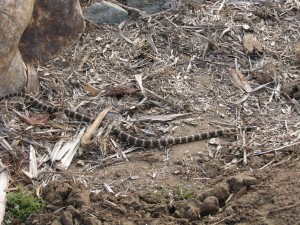
Banded kingsnake Kingsnakes are a little more tetchy than gopher snakes, and will eat other snakes including rattlesnakes. They can be striped or banded, even in the same clutch of eggs. Just like siblings with different hair colors.
Speaking of ponds, the standing water in the lower pond hasn’t receded very much, but has had an algae bloom.

Pea Soup Pond I’m going to have to have a well drilled on site, and have spoken with two well drillers and have received one bid, and am waiting for the third day for a call back. Honestly, is there so much work for some people in this economy that they can’t return phone calls or show up to appointments? During this gardening adventure of the last few months there have been several people of different occupations who just haven’t kept appointments or returned calls although they are still in business and initially shown interest. What’s up? Grrr.
The quinoa (pro: keen– wah) is doing well, and the potatoes are ready to harvest.
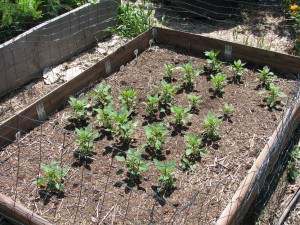
Quinoa rows Although I planted a whole packet of sunflower seeds throughout the property, only this blue jay-planted one in my strawberry bed came to anything. It looks like a puckered face!
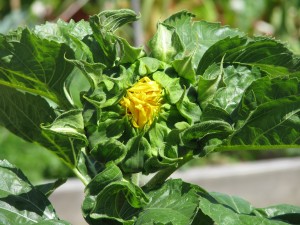
"Too much lemon!" -
Genetically Modified Foods, and a curious, unrelated photo
Genetically modified food (GMs) are what happens when scientists manipulate cells or even nuclei by inserting genes or viruses to change the DNA. Before GMs farmers would hybridize plants by breeding for preferred character traits. GMs may or may not cause damage to human DNA, but it’s use has escalated the use of pesticides, herbicides and animal cruelty. Since Monsanto, the makers of the herbicide Roundup(tm) are also the leaders in GM food, it seems that they are lining their own pockets by selling products for both cause and effect. If eating GM food is something you’d rather not do, I have just come across a useful article that might help. In the April/May, 2011 Vegetarian Times, there is an article by Neal D. Barnard, MD on the subject. In the article he reveals that manufacturers in the U.S and Canada aren’t required to label GM food. However he says that most US-grown corn, soy, cotton, Hawaiian papaya and canola is GM, but most other fresh fruit or vegetables aren’t, such as apples, oranges, bananas, broccoli. (These, however, are often heavily sprayed with pesticides and need to be washed before eating. The Environmental Working Group http://www.ewg.org/ updates a Dirty Dozen and Clean Fifteen list of produce that is effected most or least by pesticides; you can see that list here: http://www.healthyreader.com/2008/05/13/12-most-contaminated-fruits-and-vegetables/ .)
Dr. Barnard goes on to give these interesting tidbits: The labels on fresh produce carry a four-digit standardized code for cashiers to look up the price of the item, called a PLU (price look-up). If the code is preceded by an 8, it is genetically modified. If preceded by a 9, it is organic, and organics cannot be genetically modified. So watch your tofu packages if you don’t want GM soybeans.
Since becoming a vegetarian some sixteen years ago, I’ve been a label reader (even now when it requires pulling out my glasses or holding a can at arm’s length!). The amount of sodium in foods is outrageous, as is the amount of sweetners such as corn syrup. High amounts of salt and sugar is in there not for taste, but for its addictive qualities. When you eat salt or sugar, just like drinking caffeine, you crave more. As a vegetarian, it’s amazing what meat products are slid into foods, even those toted to be vegetarian. Now there is a more dangerous enemy than bad nutrition in packaged food. In my opinion, it is that of GM food and heavy herbicide and pesticide use. Even more reason to shop locally and organically, or to grow as much food as you can, and read all the labels. I am an ethical vegetarian, meaning that I decline to eat animals because I am protesting their horrible treatment and slaughter. GM animals are bred to continuously give milk, to grow enormous, to provide more of what humans eat off of them, despite the physical agony it brings. That coupled with already nightmarish living conditions is a monsterous state of affairs. Then humans injest the modified DNA, the herbicides that the animals eat that was sprayed on their food, and the pesticides that was sprayed directly on the animals. It is not a practice of which I will be a part.
Okay, I’m stepping off my soapbox now. As promised, I have a curious, unrelated photo. I have to balance reality with humor to keep sane This was taken by my daughter as we left the area on our recent Oregon sojourn, and we ask ourselves, “Huh?” A really big blowhorn faced the wrong way? A jet engine, faced the wrong way? A hood ornament…. faced the wrong way? Something unusual that fell out from under the car? A neutron accelerator? I love the care of placing a skid under the thing to protect the hood, but cinching the straps so tightly it dents the sides! Another funny incongruency in life, which keeps that humor in living. Any suggestions as to what? Or better yet, why?

Hood Ornament 
Horn? -
Jeweled Kasha
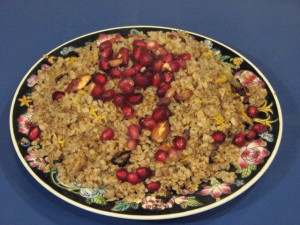
Inspired by the wonderful fruit and nut studded rice dishes of the Middle East, I came up with this and it really worked! Kasha is roasted buckwheat groats, and if you have not tried it, you really should. I find some grains hard to get through sometimes, but kasha is just plain yummy. It is also very low in fat, and high in protein. It can be made sweet for breakfast, or savory as a side dish or stuffing. In this recipe, the kasha plus the almonds and egg make it an even better protein source, and with the pomegranate seeds and seasonings, high in antioxidants and very low in fat and sodium. Can’t beat that with a stick!
2 cups water
2 tablespoons olive oil
1 cup kasha
1 egg (or egg white)
¼ cup whole almonds
½ tsp. ground cinnamon
½ tsp. fresh orange zest
Salt and pepper to taste
¼ cup water
¼ cup fresh pomegranate seeds
Boil water and oil in a medium saucepan that has a tightly fitting lid. Lightly beat egg in a bowl with a fork and stir in the kasha kernels to coat. In a separate skillet, heat egg-coated kasha over high heat, stirring constantly until the egg has dried and the kernels are more-or-less separate. Quickly stir kasha into boiling water. Cover tightly, reduce heat and simmer 7-10 minutes until kernels are tender and liquid is absorbed (water hangs out at the bottom if not done. Check with fork rather than spoon so you don’t mash the fluffy kernels). In the skillet you just used, toast the almonds over medium-high heat stirring constantly for about 3 minutes. You should just start to smell them. Add cinnamon, a pinch salt and a little freshly ground pepper and stir for one minute. Add orange zest and ¼ cup water and stir until almost dry. When kasha is done, take off heat and stir in almond mixture and pomegranate seeds. Serve immediately. Makes about 4 cups; serves 4-6.
Variations: lightly brown sliced onions and/or mushrooms and stir them in with the almond mixture.
